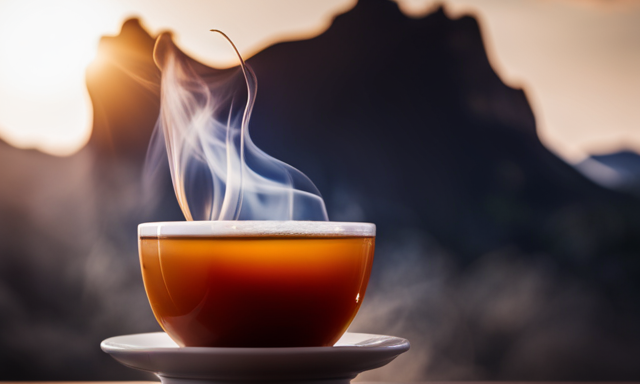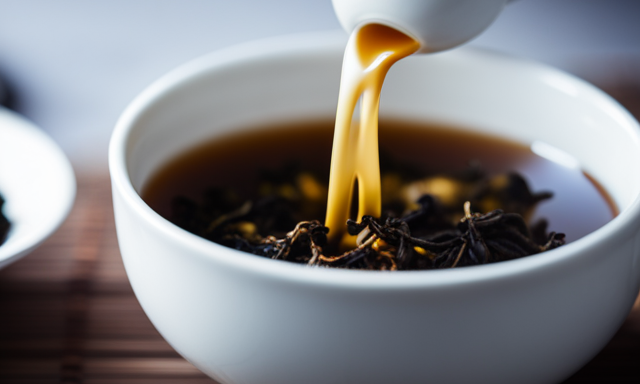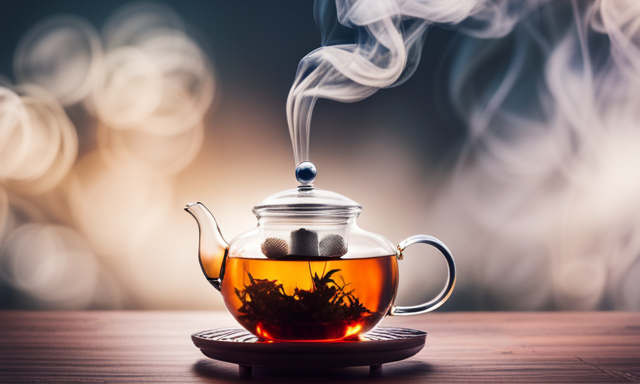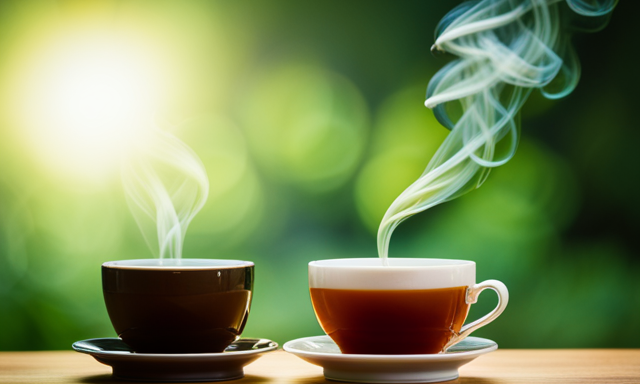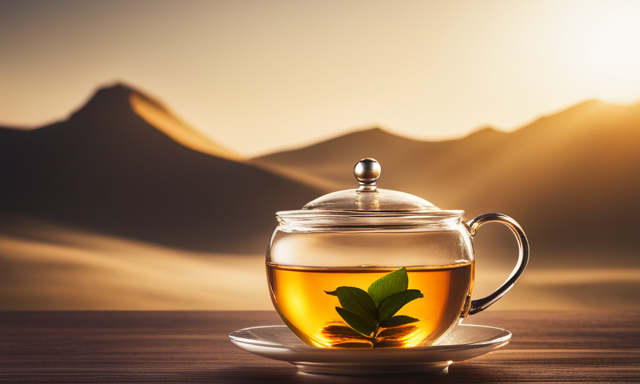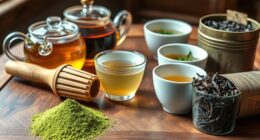Did you know that oolong tea is the most popular tea in Asia, accounting for 20% of the total tea consumption? As a tea enthusiast, I have always been intrigued by the diverse flavors and aromas that different types of tea offer. Among them, roasted oolong tea stands out with its unique taste profile.
Roasted oolong tea undergoes a special process that imparts toasty and nutty flavors, complemented by smooth and earthy undertones. The aroma of this tea is rich and inviting, with hints of roasted nuts and a subtle sweetness. It is a truly delightful experience for the senses.
Not only does roasted oolong tea offer a delightful taste experience, but it also comes with a range of health benefits. From boosting metabolism to improving digestion, this tea has much to offer.
So, grab a cup of roasted oolong tea and join me as we delve into the captivating flavors and aromas of this exquisite beverage.
Key Takeaways
- Roasted oolong tea has warm and earthy undertones.
- It pairs well with both sweet treats and savory dishes.
- The tea enhances the flavors of desserts with caramel, honey, and vanilla.
- Roasted oolong tea is a rich source of antioxidants and promotes digestive health.
A Brief Overview of Oolong Tea
A brief overview of oolong tea reveals its unique flavor profile and rich aroma. Oolong tea is known for its complex and delicate taste. It comes in a wide range of varieties, each with its own distinct characteristics. This partially oxidized tea undergoes a meticulous production process. First, the leaves are plucked and withered. Then, they are oxidized before being heated or roasted. The level of oxidation determines the flavor profile, which can range from floral and fruity to woody and toasty. The roasting process further enhances the tea’s flavors, adding depth and complexity. As the leaves are roasted, they develop caramelized and nutty notes, resulting in a smooth and robust infusion. This careful craftsmanship and attention to detail create an exquisite cup of roasted oolong tea, full of character and depth.
The Roasting Process
When it comes to the roasting process of oolong tea, it’s a meticulous and delicate art that requires skill and experience.
The tea leaves are carefully selected and then subjected to controlled levels of heat, which brings out their unique flavors and aromas.
Different levels of roasting can vary from light to medium to heavy, each imparting its own distinct characteristics and nuances to the final brew.
How the Tea Leaves are Roasted
Imagine the rich, smoky aroma of the tea leaves as they dance over the open flames, teasing your taste buds with their bittersweet allure. The process of roasting tea leaves is a delicate art, where the master tea artisan carefully controls the temperature and timing to bring out the desired flavors. The roasting techniques used greatly impact the final taste of the tea. As the leaves are roasted, they undergo chemical changes, resulting in a unique combination of flavors that range from woody and nutty to caramel and chocolatey. To understand the different levels of roasting and their effects on flavor, let’s delve into a table that showcases the variations in taste and aroma based on the duration and intensity of roasting. This will give us a deeper understanding of how roasting transforms the tea leaves, enhancing their flavors and creating a symphony of taste sensations.
Different Levels of Roasting and their Effects on Flavor
Different levels of roasting have a significant impact on the flavor of oolong tea. Lightly roasted oolong teas have a delicate and floral flavor, with hints of orchids and honey. As the roasting intensifies, the tea develops a richer, more robust taste profile, characterized by notes of caramel and toasted grains. Medium-roasted oolongs offer a harmonious balance between floral and toasty flavors, while heavily roasted varieties boast a depth of flavor akin to dark chocolate and roasted nuts. These distinct flavor profiles highlight the remarkable complexity of roasted oolong tea.
Toasty and Nutty Flavors
Roasted oolong tea envelops your taste buds with its warm, toasty notes and a hint of nuttiness, creating a sensory experience reminiscent of a cozy campfire on a crisp autumn night. The toasty flavors of the roasted oolong are the result of a careful process that infuses the leaves with a rich, smoky essence. As you take a sip, the tea’s nutty undertones gently unfold, adding a layer of complexity to the overall taste profile. This unique combination of toasty and nutty flavors creates a harmonious balance that is both comforting and invigorating. Each sip offers a smooth and earthy undertone that lingers on the palate, leaving a satisfying aftertaste. It’s like taking a stroll through a sun-drenched forest, with every sip revealing a new layer of nature’s elegance.
Smooth and Earthy Undertones
As I savor a cup of roasted oolong, the smooth and earthy undertones gently caress my palate, immersing me in a serene and grounding experience.
The earthy flavor of this tea is subtle yet distinct, providing a sense of connection to nature with every sip.
The brewing techniques used to prepare roasted oolong further enhance its smoothness and earthiness. Whether brewed in a traditional teapot or through the modern method of gongfu style, the result is a tea that embodies balance and harmony.
The careful selection of leaves, the precise water temperature, and the steeping time all contribute to the rich and velvety texture of the brew.
As I delve deeper into the world of roasted oolong, I am excited to explore the diverse aroma profiles that await, evoking a sensory journey beyond compare.
Aroma Profiles
When it comes to the aroma profiles of roasted oolong tea, there are three key points to consider: floral notes, woody notes, and roasted notes.
The floral notes in the tea create a delicate and enchanting fragrance that is reminiscent of blooming flowers in a serene garden.
The woody notes add a sense of depth and richness to the aroma, evoking images of a quiet forest filled with aged trees.
Lastly, the roasted notes provide a comforting and inviting scent, reminiscent of a warm hearth on a cold winter’s day.
Together, these aroma profiles create a captivating olfactory experience that enhances the overall enjoyment of roasted oolong tea.
Floral Notes
Imagine sipping on a cup of roasted oolong tea, and suddenly you are enveloped in the delicate and intoxicating essence of floral notes.
The flavor intensity of roasted oolong tea allows the subtle floral undertones to shine through, creating a sensory experience that is both soothing and invigorating.
The brewing techniques used for roasted oolong tea further enhance its floral character, as the leaves are gently infused with hot water, coaxing out the floral aromas and flavors.
Each sip tantalizes the palate with the essence of blossoms, transporting you to a tranquil garden in full bloom.
As the floral notes dance on your tongue, they seamlessly transition into the subsequent section, where woody and roasted notes take center stage, adding depth and complexity to the overall flavor profile.
Woody and Roasted Notes
Indulge in the warm embrace of woody and roasted notes. They envelop your senses and add a rich complexity to your tea experience.
The woody flavors offer a subtle earthiness, reminiscent of a stroll through a forest filled with ancient trees. These flavors evoke a sense of tranquility and grounding, complementing the tea’s overall character.
The roasted aroma, on the other hand, adds a comforting warmth that lingers in the air. It invites you to take a moment to savor each sip. It infuses the tea with a robust, smoky essence that brings depth and intensity to the flavor profile.
Together, the woody flavors and roasted aroma create a harmonious marriage that elevates the tea to new heights.
As you transition into exploring the mouthfeel and texture, prepare to discover a whole new realm of sensory delights.
Mouthfeel and Texture
If you’re skeptical about the texture of roasted oolong tea, you’ll be pleasantly surprised by its smooth and velvety mouthfeel. As you take your first sip, the tea gracefully coats your palate, leaving behind a comforting sensation that is both luxurious and satisfying.
The texture is reminiscent of a fine silk fabric, gliding effortlessly across your tongue. This mouthfeel perfectly complements the flavor profile of roasted oolong tea, which is rich, toasty, and slightly nutty.
The combination of the smooth texture and the robust flavor creates a truly indulgent experience for the senses. Now, as we delve into pairing suggestions, you’ll discover how to elevate your enjoyment of roasted oolong tea even further.
Pairing Suggestions
When it comes to pairing roasted oolong tea, there are two key points to consider: sweet treats and savory dishes.
Personally, I find that the rich, toasty flavors of the tea perfectly complement sweet treats such as buttery shortbread cookies or decadent chocolate truffles.
On the other hand, the earthy undertones of roasted oolong tea also pair wonderfully with savory dishes like grilled salmon or roasted duck, adding depth and complexity to the overall dining experience.
Sweet Treats
Roasted oolong tea has a delightful flavor that pairs perfectly with sweet treats. Its rich, toasty notes create a harmonious balance when enjoyed alongside a variety of dessert options.
The tea’s warm and earthy undertones complement the sweetness of pastries, cakes, and cookies, enhancing their flavors in a way that is truly exceptional. Sipping on a cup of roasted oolong while indulging in a decadent chocolate cake or a delicate fruit tart is a sensory experience that is both comforting and indulgent.
The natural sweetness of the tea also brings out the subtle nuances of caramel, honey, and vanilla in desserts, elevating their taste profiles to new heights. Each sip of the tea washes over the palate, leaving behind a lingering sweetness that enhances the overall enjoyment of the sweet treats.
Transitioning into the subsequent section about savory dishes, roasted oolong tea also has the versatility to complement a wide range of hearty and flavorful savory dishes.
Savory Dishes
Indulge in the rich and savory flavors of roasted oolong tea as it effortlessly complements a wide array of hearty and delicious dishes. This exquisite tea infuses a unique umami essence into savory tea recipes, elevating them to new heights of flavor.
Here are three tantalizing options to explore:
-
Roasted oolong tea-marinated chicken: The smoky notes of the tea perfectly enhance the succulent meat, creating a delectable combination of flavors.
-
Oolong tea-infused risotto: The earthy and nutty undertones of the tea meld beautifully with the creamy rice, resulting in a velvety and comforting dish.
-
Oolong tea-braised beef stew: The robustness of the tea adds depth and complexity to the stew, making each bite a savory delight.
These savory creations are just a glimpse of the culinary possibilities with roasted oolong tea. Moving forward, let’s delve into the health benefits of this remarkable tea.
Health Benefits of Roasted Oolong Tea
When it comes to the health benefits of roasted oolong tea, two key points stand out: its high antioxidant content and its ability to aid in digestion.
As a tea enthusiast, I have found that roasted oolong tea is a rich source of antioxidants, which help combat free radicals and promote overall well-being.
Additionally, this tea has been known to soothe the digestive system, easing discomfort and promoting healthy digestion.
Antioxidant Content
Immerse yourself in the rich flavor of roasted oolong tea and discover its impressive antioxidant content. This exquisite tea is not only a delight for your taste buds, but it also offers numerous health benefits due to its high antioxidant levels.
Antioxidants are essential for our overall well-being as they help protect our cells from damage caused by free radicals. Roasted oolong tea is particularly rich in antioxidants, making it a great choice for those looking to boost their antioxidant intake.
However, it is important to note that while roasted oolong tea has many antioxidant benefits, it may also have potential side effects. Therefore, it is always recommended to consume it in moderation.
Transitioning into the next section, roasted oolong tea is also known for its digestive aid properties.
Digestive Aid
Experience the soothing and comforting effects of roasted oolong tea as it gently eases your digestive discomfort. This tea not only delights the senses but also promotes digestive health. The warm, toasty notes of roasted oolong tea work in harmony with your body, providing a natural remedy for any digestive issues.
Sipping on a cup of this tea can help to calm an upset stomach, alleviate bloating, and aid in digestion. Its natural properties support gut health, allowing your digestive system to function optimally. So, whether you’re experiencing occasional indigestion or simply want to maintain a healthy digestive system, roasted oolong tea is the perfect choice.
Transitioning into the subsequent section about brewing tips, let’s explore how to prepare this exquisite tea to maximize its benefits.
Brewing Tips
When it comes to brewing the perfect cup of roasted oolong tea, there are a few key factors to consider. First, the water temperature is crucial. Ideally, the water should be around 195-205°F (90-96°C). This temperature allows the flavors and aromas of the tea to fully develop without becoming bitter.
Next, steeping time is important. It’s recommended to steep roasted oolong tea for 3-5 minutes. However, the exact time can be adjusted based on personal preference. Steeping for a shorter time will result in a lighter flavor, while a longer steeping time will create a stronger and more robust cup of tea.
Lastly, the tea-to-water ratio is another factor to consider. A good starting point is to use 1 teaspoon of tea leaves for every 8 ounces of water. However, this ratio can be adjusted to taste. Some people prefer a stronger brew and may use more tea leaves, while others may prefer a milder flavor and use less.
By paying attention to these brewing tips, you can ensure that you are getting the most out of your roasted oolong tea and enjoying a flavorful and well-balanced cup every time.
Water Temperature and Steeping Time
Brewing roasted oolong tea is like finding the perfect balance between hot and cold, where the water temperature and steeping time dance together to unlock the tea’s rich and complex flavors. The quality of the water plays a crucial role in the final taste of the tea. Using filtered or spring water ensures that impurities don’t affect the delicate flavor profiles. The water temperature should be around 195°F (90°C) to 205°F (96°C) to fully extract the tea’s essence without scalding it. Steeping time is equally important, as it allows the leaves to release their distinct flavors gradually. Typically, a steeping time of 3-5 minutes is recommended. This careful attention to water temperature and steeping time guarantees that every cup of roasted oolong tea is a sensory delight. As we move into the next section about tea-to-water ratio, we can further explore the art of brewing this exquisite tea.
Tea-to-Water Ratio
Achieving the perfect cup of roasted oolong tea is all about finding the right balance between the amount of tea leaves and the volume of water used. The tea-to-water ratio plays a crucial role in determining the tea strength and flavor.
Too much tea and the brew may become overpowering, while too little may result in a weak and insipid taste. Finding the sweet spot requires experimentation and an understanding of different brewing techniques.
Some prefer a stronger brew and opt for a higher tea-to-water ratio, while others enjoy a lighter infusion and use less tea. Adjusting the ratio allows you to tailor the tea to your personal preference, whether you prefer a bold and robust cup or a delicate and fragrant sip.
Understanding the impact of the tea-to-water ratio is essential in mastering the art of brewing roasted oolong tea.
Now, let’s explore where to buy this exquisite tea.
Where to Buy Roasted Oolong Tea
To find roasted oolong tea that will tantalize your taste buds, you should explore specialty tea shops in your area. These shops offer a curated selection of teas, ensuring that you get the highest quality and most authentic experience. The knowledgeable staff can guide you through the different varieties and recommend the perfect roasted oolong tea to suit your preferences.
However, if you prefer the convenience of online shopping, there are also numerous reputable online retailers that offer a wide range of roasted oolong teas. They provide detailed descriptions and customer reviews, allowing you to make an informed decision from the comfort of your own home.
Whether you choose to explore local shops or browse online, the world of roasted oolong tea is just a click or a step away.
Frequently Asked Questions
How does the roasting process affect the caffeine content of oolong tea?
The roasting process of oolong tea can have a significant impact on its caffeine content. While roasting can slightly reduce caffeine levels, the flavor profile of the tea is more affected by the roasting process.
Can the toasty and nutty flavors in roasted oolong tea vary depending on the roast level?
Yes, the toasty and nutty flavors in roasted oolong tea can indeed vary depending on the roast level. The different levels of roasting bring out unique flavor profiles, ranging from delicate and floral to rich and robust.
Are there any differences in aroma profiles between different types of roasted oolong tea?
Different roasting techniques produce distinctive aroma profiles in roasted oolong tea. The origin of the tea leaves also influences the aroma, adding nuances like floral, fruity, or earthy notes that enhance the sensory experience.
What factors contribute to the smooth and earthy undertones in roasted oolong tea?
Roasting techniques, such as charcoal roasting, greatly influence the flavor development of roasted oolong tea. By imparting smoky and toasty notes, these techniques contribute to the smooth and earthy undertones that make the tea so captivating.
Are there any specific health benefits associated with drinking roasted oolong tea compared to other types of tea?
Roasted oolong tea offers potential weight loss effects and antioxidant properties compared to other teas. Its unique combination of compounds may enhance metabolism and fat oxidation, promoting weight management and overall health.
Conclusion
In conclusion, experiencing the rich and complex flavors of roasted oolong tea is like embarking on a sensory journey through a serene tea garden.
The toasty and nutty notes dance on your palate, while the smooth and earthy undertones provide a soothing embrace.
With each sip, the aroma transports you to a world of tranquility.
So, why not indulge in this exquisite beverage and add a touch of elegance to your daily routine?
After all, a cup of roasted oolong tea is like a symphony of flavors, a true feast for the senses.

